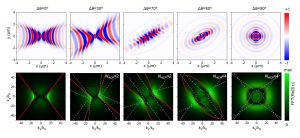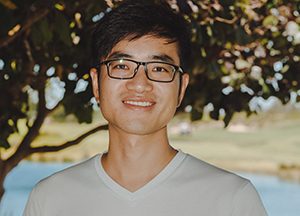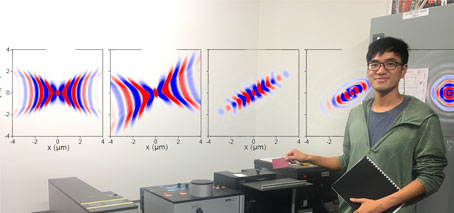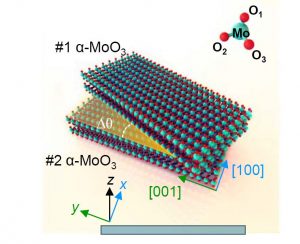- ‘Twisted’ layers of 2D materials produce photonic topological transition at ‘magic’ rotation angles
- Principles of Moire-pattern bilayer graphene applied to 2D material photonics for first time
Monash researchers are part of an international collaboration applying ‘twistronics’ concepts (the science of layering and twisting 2D materials to control their electrical properties) to manipulate the flow of light in extreme ways.
The findings, published today in the journal Nature, hold the promise for leapfrog advances in a variety of light-driven technologies, including nano-imaging devices; high-speed, low-energy optical computers; and biosensors.
This is the first application of Moiré physics and twistronics to the light-based technologies, photonics and polaritonics, opening unique opportunities for extreme photonic dispersion engineering and robust control of polaritons on 2D materials.
Applying twistronics to photons
The team took inspiration from the recent discovery of superconductivity in a pair of stacked graphene layers that were rotated to the ‘magic twist angle’ of 1.1 degrees.

A bilayer of molybdenum trioxides supports highly collimated, directive, and diffractionless propagation of nano-light when the two layers are aligned at the photonic ‘magic angle’.
In this stacked, misaligned configuration, electrons flow with no resistance, while separately, each of the two graphene layers shows no special electrical properties.
The discovery has shown how the careful control of rotational symmetries can unveil unexpected material responses.
The research team was led by Andrea Alù at the Advanced Science Research Center at the Graduate Center, CUNY, Cheng-Wei Qiu at National University of Singapore and Qiaoliang Bao formerly at Monash University.
The team discovered that an analogous principle can be applied to manipulate light in highly unusual ways. At a specific rotation angle between two ultrathin layers of molybdenum-trioxide, the researchers were able to prevent optical diffraction and enable robust light propagation in a tightly focused beam at desired wavelengths.
Typically, light radiated from a small emitter placed over a flat surface expands away in circles very much like the waves excited by a stone that falls into a pond. In their experiments, the researchers stacked two thin sheets of molybdenum-trioxide and rotated one of the layers with respect to the other. When the materials were excited by a tiny optical emitter, they observed widely controllable light waves over the surface as the rotation angle was varied. In particular, they showed that at the photonic ‘magical twist angle’ the configured bilayer supports robust, diffraction-free light propagation in tightly focused channel beams over a wide range of wavelengths.

Dr Qingdong Ou (Monash University) with s-SNOM facility at Melbourne Centre for Nanofabrication (MCN)
“While photons – the quanta of light – have very different physical properties than electrons, we have been intrigued by the emerging discovery of twistronics, and have been wondering if twisted two-dimensional materials may also provide unusual transport properties for light, to benefit photon-based technologies,” said Andrea Alù.
“To unveil this phenomenon, we used thin layers of molybdenum trioxide. By stacking two of such layers on top of each other and controlling their relative rotation, we have observed dramatic control of the light guiding properties. At the photonic magic angle, light does not diffract, and it propagates very confined along straight lines. This is an ideal feature for nanoscience and photonic technologies.”
“Our experiments were far beyond our expectations,” said Dr Qingdong Ou, who led the experimental component of the study at Monash University. “By stacking ‘with a twist’ two thin slabs of a natural 2D material, we can manipulate infrared light propagation, most intriguingly, in a highly collimated style.”
“Our study shows that twistronics for photons can open truly exciting opportunities for light-based technologies, and we are excited to continue exploring these opportunities,” said National University of Singapore graduate student Guangwei Hu, who led the theoretical component.

Field distributions (top panel) and corresponding dispersion (bottom panel) at varying rotation angle
“Following our previous discovery published in Nature in 2018, we found that biaxial van der Waals semiconductors like α-MoO3 and V2O5 represent an emerging family of material supporting exotic polaritonic behaviors,” said A/Prof Qiaoliang Bao, “These natural-born hyperbolic materials offer an unprecedented platform for controlling the flow of energy at the nanoscale.”
Development of twistronics and magic angles in graphene
Novel electronic properties in ‘misaligned’ graphene sheets was first predicted by National University of Singapore Professor (and FLEET Partner Investigator) Antonio Castro Neto in 2007, and the ‘magic angle’ of 1.1 degrees was theorised by FLEET PI Allan MacDonald (University of Texas in Austin) in 2011.
Superconductivity in twisted graphene was experimentally demonstrated by Pablo Jarillo-Herrero (MIT) in 2018.
The study

Dr Qingdong Ou performed experimental studies while working with A/Prof Qialiang Bao in Monash University’s Dept. of Material Science and Engineering. Qingdong’s condensed-matter research continues with Prof Michael Fuhrer in Monash School of Physics and Astronomy.
Topological polaritons and photonic magic angles in twisted α-MoO3 bi-layers was published in Nature in June 2020 (DOI 10.1038/s41586-020-2359-9 ).
As well as support from the Australian Research Council, support was also provided by the US Air Force Office of Scientific Research, Vannevar Bush Fellowship, Office of Naval Research, and National Science Foundation, as well as Singapore’s Agency for Science Technology and Research (A*STAR), and China’s National Natural Science Foundation.
Layering and twisting of 2D materials was performed at Monash University (Department of Materials Science and Engineering), while the topological polaritons was observed and characterised at the Melbourne Centre for Nanofabrication (MCN), the Victorian Node of the Australian National Fabrication Facility (ANFF).
Photonics at FLEET
Experimental physicist Dr Qingdong Ou is a research fellow now working with Prof Michael Fuhrer at Monash University to study nano-device fabrication based on 2D materials, within FLEET’s Enabling technology B.
Qingdong seeks to minimise energy losses in light-matter interactions, aiming to realise ultra-low energy consumption in 2D-material-based photonic and optoelectronic devices. He also studies highly-confined low-loss polaritons in 2D materials using near-field optical nano-imaging within FLEET’s Research theme 2.
FLEET is an Australian Research Council Centre of Excellence developing a new generation of ultra-low energy electronics.
More information
- Contact Prof Andrea Alù (CUNY ASRC) aalu@gc.cuny.edu
- Contact A/Prof Cheng-Wei Qiu (National University of Singapore) chengwei.qiu@nus.edu.sg
- Contact A/Prof Qiaoliang Bao (formerly Monash University) qiaoliang.bao@gmail.com
- Contact FLEET media@fleet.org.au
- Follow @FLEETCentre



